If you are an avid runner and have recently suffered from an ankle sprain, you may wonder when it is safe to return to running. Ankle sprains can happen to anyone, and they can be quite painful.
The worst part of an ankle sprain for runners isn’t even the pain. It’s the mental side of having to take a break from running! Believe me, I get it. There are times I’d rather take a needle to the eye than have to stop running for any length of time.
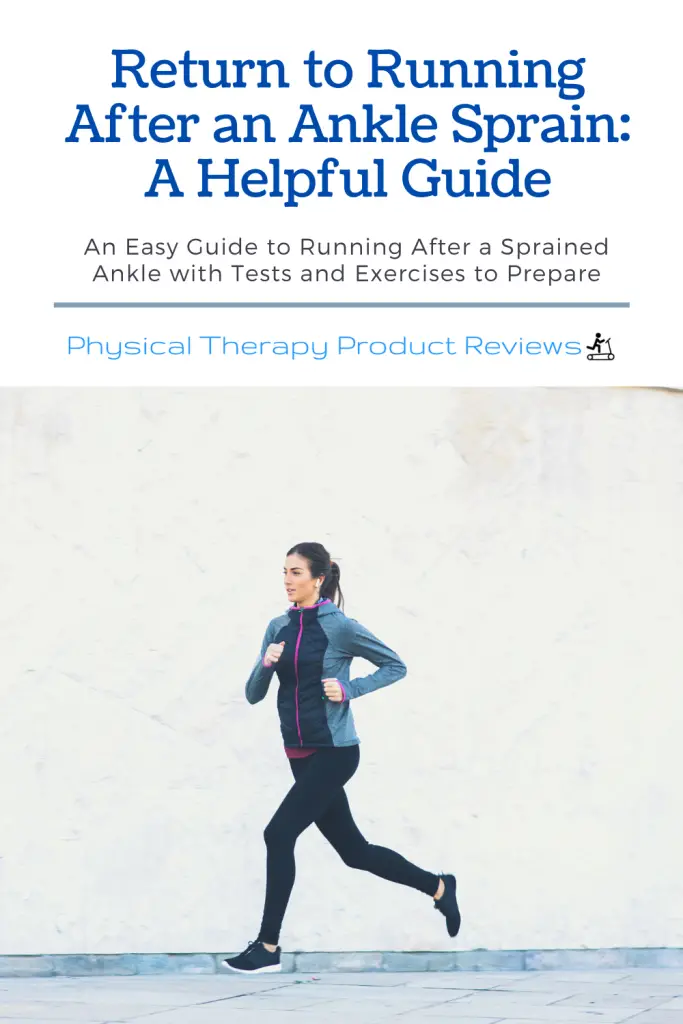
However, depending on the severity of your sprain, returning to running too soon can slow your recovery process. What if there were exercises and ways to speed up returning to running?
This blog post will discuss everything you need to know about returning to running after an ankle sprain and what you can do now to keep your sanity and get back to running faster and more robust.
What is an Ankle Sprain?
An ankle sprain is a common injury that can occur when you roll your ankle. This can happen when running on uneven surfaces, making a sudden change in direction, or landing awkwardly after a jump.
Ankle sprains usually result in pain, swelling, and bruising around the affected area. In more severe cases, you may even hear a popping sound when the injury occurs.
When the ankle rolls, or what’s also called “inverts,” it stretches and, in most cases, causes minor tearing in the ligaments of the ankle. Most people have experienced mild “rolling” of their ankles in sports or walking on uneven ground.
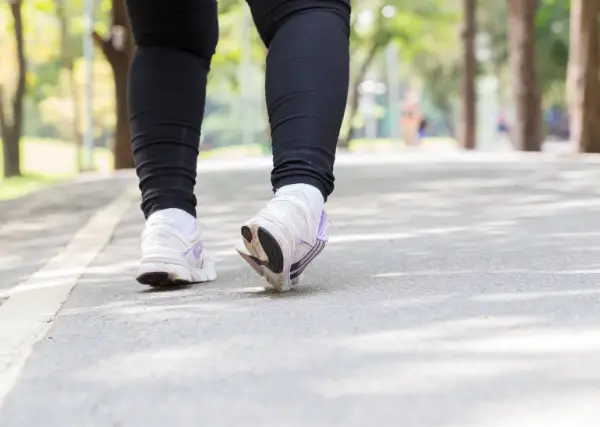
Ankle sprains are graded on how far those ligaments are stretched.
Grade 1 injuries are usually mild and take anywhere from 2-4 weeks to heal, while grade 3 injuries are more severe and may take many months to recover fully.
As you can see in the chart below, a grade 1 ankle sprain may only require a short break from running. There is typically only damage to one ligament, the ATFL, with mild swelling and bruising.
On the other end of the spectrum, a grade 3 ankle sprain is severe. There is tearing or damage to all three of the lateral ankle ligaments. There is significant swelling and bruising, and it isn’t easy to walk and put weight on the ankle standing. These often require extensive care, a walking boot, and bracing to reach normal levels.
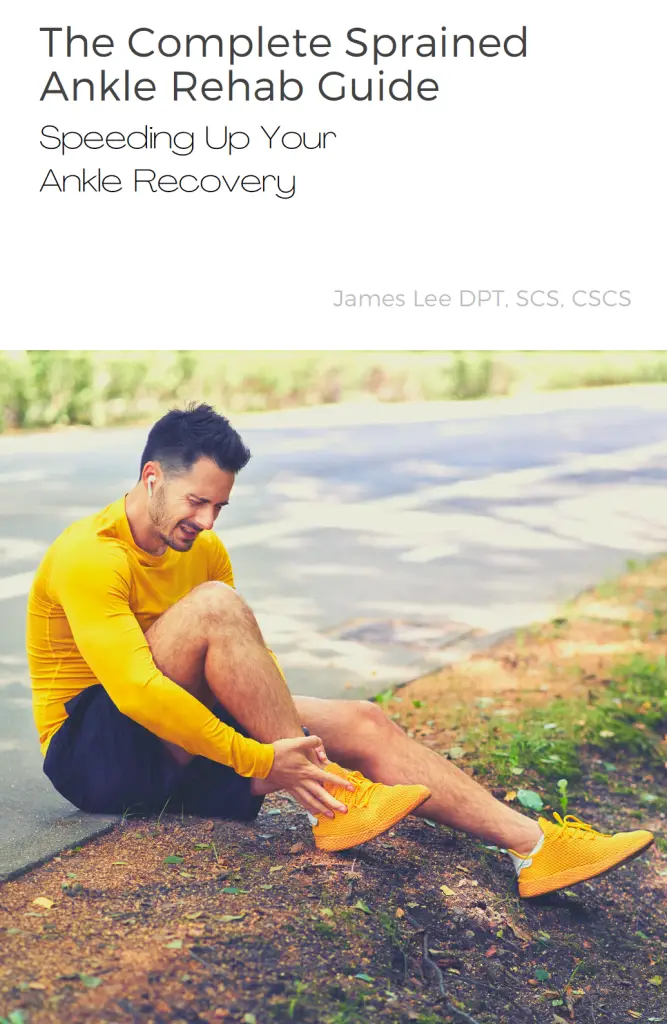
Want to recover faster and stronger after an ankle sprain? See our complete rehab guide with exercises and tips to speed up your recovery.
How Long Does a Sprained Ankle Take to Heal?
The amount of time it takes for a sprained ankle to heal will depend on the severity of the injury. For milder sprains, you may be able to return to running within a few weeks. However, the recovery process could take several months for more severe sprains.
| Grade of Sprain | Symptoms |
|---|---|
| Grade 1 | Involve a small amount of tearing to the ATFL ligament and can usually be treated at home. This injury grade typically resolves quickly with activity and strengthening exercises. Mild to little muscle damage typically requires no bracing, although a light ankle compression sleeve may help for a short period. |
| Grade 2 | Involve a moderate amount of damage to the ligaments. This grade of injury may involve a full tear of the ATFL and a tear of the CFL. This also includes likely muscle and tendon stretching and significant swelling. At this level, expect bruising, difficulting walking for a period of time without crutches, and does respond well to using a lace-up ankle brace. |
| Grade 3 | Involve a complete tear of the ligaments and will take extensive time to recover. This is a complete tear of the ATFL, CFL, and some degree of damage to the PTFL. This also includes muscle/tendon tearing and the potential of a bone bruise. This injury causes severe difficulty walking, considerable swelling, and pain with putting pressure through the foot. Grade 3 sprains require crutches and will need a walking boot to allow for proper soft tissue healing. |
The major concern for more severe ankle sprains is letting the ligaments fully recover before putting too much stress on them with running.
Some of you might ask, “What’s it matter if I run too early? Isn’t it only pain that I can push through?”
Unfortunately, if the ankle doesn’t heal properly, it can lead to chronic Ankle Instability. In this condition, the ankle becomes permanently unstable, leading to pain and eventually more serious conditions such as Osteoarthritis and Ankle Impingement, among other things.
If you have doubts about whether your ankle is fully healed, it is always best to err on the side of caution and consult with a physiotherapist before returning to running.
How Soon Can I Start Running Again?
If you have suffered from a mild ankle sprain, you may be able to start running again within a few weeks. However, it is important to listen to your body and not push yourself too hard. If your pain persists or gets worse, then your ankle is still healing and is not ready for the impact of running.
The best way to know that you are ready to run is to pass a series of tests that we use in the clinic. If you can pass these tests with a 90% or greater score compared to your other ankle, you can be confident you can return to running without causing further damage.
Knee-to-Wall Test
The knee-to-wall test is simple but important to assess your ankle’s range of motion. Many people don’t realize how much ankle motion they lose until they try this test.
To perform this test:
- Lay down a tape measure on the floor with the end against the wall
- While barefoot, put your big toe of one foot at the 5 inches mark
- Try and bend your knee to touch the wall on the same foot without letting your heel come off the ground
- Then try with the other foot and compare the distances or the difference between each foot
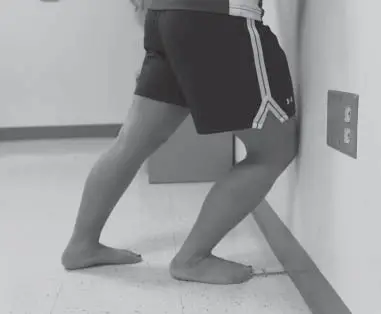
The goal of this test is to be symmetrical and close to the normal range of motion of 5 inches away from the wall. If you are still not symmetrical, you must continue to work on it until it is.
Related Article: Here is a helpful post on other ideas to improve ankle dorsiflexion at home.
Timed Single-Leg Calf Raise Test
This test is important to assess the strength of your gastrocnemius and soleus muscles in the back of your leg. These are the muscles that help control ankle motion when running.
To perform this test:
- Place a stopwatch or timer next to you on the floor
- Stand on one leg with the ball of your foot on the edge of a step or elevated surface.
- Time yourself for 30 seconds and count how many complete heel raises you can do in that time period.
- Perform on the other leg and compare the results. The goal is 90% or greater when comparing the injured ankle to the healthy ankle.
Pro Tip: Perform in front of a mirror so that you can see count not only the total repetitions but also see the quality of the movement. The height and control of the calf raise should be nearly equal during testing.
Single-Leg Figure-8 Hop Test
This is a great test to evaluate your power and control of the ankle and its readiness for repeated impact.
To perform this test, place 2 cones or some sort of oblivious markers 5 meters (16 ft., 5 in.) apart.
You will hop as fast as possible on one limb twice around the cones in a figure-8 pattern while recording your time on a stopwatch or phone.
A failed test consists of being unable to maintain the figure 8 course path or touching down with the opposite limb.
The best time from two trials is recorded. The goal is to score 95% or greater when comparing your times from each leg.
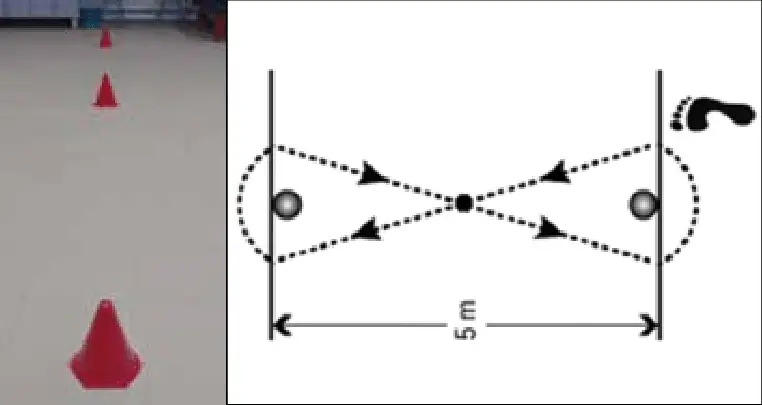
If you can pass those 3 tests with a score of 90% or greater than the other ankle, you can rest assured that you can return to running.
If you didn’t pass, then you need to continue to rehab the ankle until it’s ready. If you were close to passing, you could probably attempt light jogging and be safe. Read more below on a safe progression back to running.
To rehab an ankle to return to running, see the exercises below.
What Exercises Can I Do to Return Running?
You can do several exercises to help speed up the recovery process. The sooner you perform these exercises and build up the proper strength and control, the sooner you return to running.
These exercises aim to improve the range of motion at the ankle, improve ankle control, and increase strength to return to running and avoid re-injury.
These exercises include:
Single and Double leg Heel raises
Stand on your injured foot and slowly raise your heel off the ground. Hold this position for a few seconds before lowering your heel back down. Repeat this exercise for 30 repetitions a couple of times per day. You should feel this exercise working the back of the calf muscle.
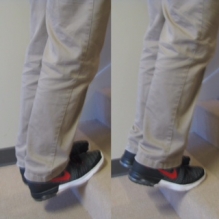
Seated Theraband Ankle Inversion/Eversion
Sit on the ground with your legs straight in front of you. Place a theraband around the bottom of both feet. Cross one foot over the top of the other and pull outwards on the band to turn your foot out (eversion). Return to the starting position and turn your foot in (inversion). Repeat this exercise for 30 repetitions a couple of times per day.
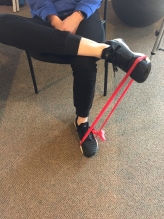
Knee-to-Wall Stretch
Stand with your injured foot a few inches away from a wall. Place your hands on the wall for support and lean forward, keeping your heel on the ground and trying to get your knee to touch the wall. You should feel a stretch in your calf muscle. Hold this position for 30 seconds before repeating it a few times daily.
Bosu Ball Single Leg Balance
Stand on one leg on an unstable surface, such as a Bosu ball. You can do this exercise on either the blue side or the black side up, both will challenge your ankle differently. We also prefer to have the knee bent slightly to make the entire leg work. Hold this position for 30 seconds before switching to the other leg. Repeat this exercise a few times per day.
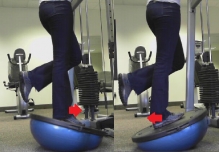
Bosu Ball Single-Leg Squats
Stand on one leg on an unstable surface, such as a Bosu ball. Slowly lower your body down into a squat position. Hold this position for 3-5 seconds before returning to standing. The unstable surface of the Bosu ball will help your ankle react and correct its current instability. Repeat this exercise on either side of the Bosu Ball for 15 repetitions and 2 sets.
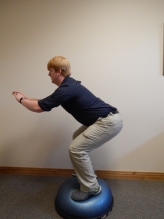
Do I Need to Wear an Ankle Brace When I Return to Running?
An ankle brace can help provide support and stability to your ankle as it heals. The brace allows for a return to normal activities sooner while also protecting the joint.
You should wear an ankle brace in certain situations with the eventual goal of building up the ankle strength to the point where you no longer need the brace.
You should wear an ankle brace if:
- Your ankle sprain is moderate to severe, and it is painful to walk without a limp
- You have pain with stairs, squatting, or trying to run
- Your ankle swells up after performing your exercises or trying to do a dynamic activity
Our favorite ankle brace to wear for running is the ASO lace-up ankle brace. It’s lightweight yet supportive enough for dynamic activities such as running. You can adjust the amount of support it has through the easy-to-use lace-up support.

Wearing an Ankle Brace for Running
For those recovering from a grade 2 or 3 ankle sprain, it’s best to wear an ankle brace as you begin your gradual return to running.
The ankles brace allows for the following:
- Support to prevent further tearing of the injured ligaments
- Reduces force on the ankle joint and bony structures
- It can help prevent a reoccurrence of swelling with running
- Reduces pain and compensations that you might not even realize you have with running
The only negative about wearing an ankle brace is that it may feel foreign and a little stiff to those who aren’t used to it. Especially those people who wear minimalist lightweight shoes for running; however, those are the ones that will benefit the most from wearing a brace in the early stages of running.
How to Safely Return to Running After a Sprained Ankle
The best way to return to running after an ankle sprain is to gradually increase your running mileage while cross-training with other activities such as swimming, biking, and the elliptical.
After a sprained ankle, the research suggests it’s important to take a slow and gradual approach to return back to your mileage.
First, you must ensure you’ve passed some of the tests mentioned above. This ensures that you have the full range of motion and that your strength is adequate to prevent further damage.

Second, think of slow and gradual progress of no more than 10-15% progression per week in either mileage or intensity.
We recommend starting with jogging for 30 seconds on and then walking for 2 minutes and alternating for a total of 20-30 minutes or a 1:4 ratio of walking to jogging. Assess how your ankle responds in terms of swelling and pain.
If there are no issues, you can safely progress to a 1:3 ratio of alternating between running for 30 seconds and walking for 1 minute and 30 seconds. Once you achieve a 1:1 ratio of 30 seconds of running to walking, you can start to progress your running in terms of both time and speed.
This safest progression allows you to start running sooner after an injury without progressing too quickly.
If you have pain or swelling after a run, then drop back to the previous ratio and stay at that level until there is no after-activity response and try to progress again.
Conclusion
Recovering from an ankle sprain can be frustrating, but following the proper protocol will ensure a safe and successful return to running.
Start slow and gradually increase your mileage while cross-training with other activities. Wearing an ankle brace can also help you transition back to running while providing support and stability. If you experience any pain or swelling after running, take a step back and reassess your plan.
With patience and consistency, you’ll be back on the road to running in no time!
Do you have any tips for returning to running after an ankle sprain? Share them with us in the comments below!
Disclaimer: The information provided in this post is for educational purposes only. This is not a substitute for a medical appointment. Please refer to your physician before starting any exercise program.

